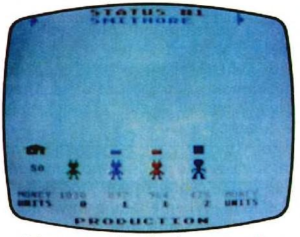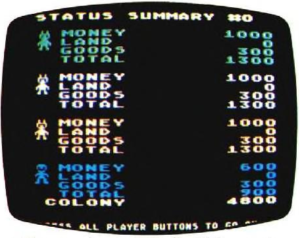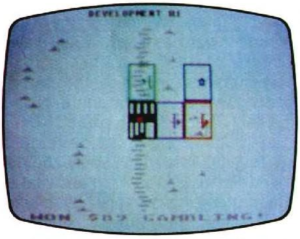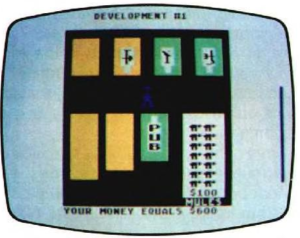This is WoM’s collection of M.U.L.E. playing strategies.
In case you want to contribute with your own strategy, please use this forum post!
As of April 2019, the strategy authors included here are:
- Dan Bunten (game designer)
- Bill Bunten (game designer)
- Jim Rushing (game designer)
- Alan Watson (game designer)
- Carl M. Evans (journalist)
- Dave Stone (reader of Computer Gaming World)
- Tracie Forman and Frank Tetro Jr (journalists)
- Joseph Fenton (reader of World of M.U.L.E.)
- Darxi (reader of World of M.U.L.E.)
Dan Bunten’s Strategy
Source: M.U.L.E. Manual
I like to win by analyzing my options.
When I am bidding in a land auction I use a little “rule of thumb” to determine how much a plot is worth. Multiply the number of turns left by 100 and add 500. This will give you the maximum bid you should make on any piece of property. In other words, bid high for land early in the game, even though you don’t have much cash; but don’t get sucked into a bidding battle later in the game just because you have lots of money.
If you want to get really sophisticated, figure out what product you will develop on the land, then figure out how many units you’ll
average, and how much it will sell for. Multiply that by the number of turns left and add it to 500. This is how the computer player
figures the value of each plot of land. But if you’re like me, you won’t be able to complete the full calculation before the auction is
over.
Bill Bunten’s Strategy
Source: M.U.L.E. Manual
My advice is: play to win. As the game begins, get into Smithore. Grab a mountain plot next to the river. Immediately yell that you missed the river, and mumble about the need for Food production. Usually that will convince at least two of the others to buy river land and develop Food.
Then don’t sell Smithore to the store. You want demand to go up and the store’s supply to go down. When the others start to notice, coast another turn by cursing your joystick for “inadvertently” flopping you to a Buyer when you were trying to be a Seller. By the next turn, they’ll be getting suspicious, and they’ll start selling all their Smithore to keep the price down. Play possum. Wait until they’re almost to the store and then step a dollar above the store price and buy all the Smithore that you can. The cat’s out now, and everyone’s on to you.
So next turn — don’t develop at all — let M.U.L.E.s free. Grab one, outfit it for food, step out of the town and push your button. If you’re quick you can set at least four free. Smithore’s price should jump to over $200. You just acquired leverage. Sell all your Smithore at the next auction. And remember, there are drawbacks to being the winning player-you always lose ties in the auction. So, if you and another player both need Food or Energy, and you’re winning, you must be conniving. Right before the auction starts, turn to him and make a chuckle like you just made a mistake. Make strong eye-contact and start explaining. By the time he realizes that the auction has started, you’ll have that little jump. So buy all the product you need, and, for good measure, buy up any that he needed, too.
Jim Rushing’s Strategy
Source: M.U.L.E. Manual
I always try to make prudent and logical decisions throughout the game, especially in the early turns. You may never recover from an early mistake like missing a land grant, not becoming self-sufficient in Food and Energy, or not leveraging every penny of excess cash.
Unless I capture a decisive advantage early in the game, I usually find myself in a dangerously vulnerable position. Then I have to use all my wits and cunning just to survive. I can often appeal to Alan’s sympathetic nature and convince him to sell me one or two units of a needed commodity, but all I ever hear from Dan or Bill is something like, “You want it, let’s see that price up to $300.” Totally ruthless. One bit of advice: if you just happen to find yourself in a winning position, and in possession of the only surplus Energy in the colony, pause for just a moment to remember all those times when the other players have helped you out; reflect on all those times that they showed pity on you and kept you alive, think about the good of the entire colony … and then, DON’T SELL.
Alan Watson’s Strategy
Source: M.U.L.E. Manual
Despite my experience with M.U.L.E., I have more ideas about how to play than about how to win. The way I play is conservative, and so I seldom win by a wide margin. It seems I need more than my share of property (11 plots) to win. So I try to get as much land as I can. Even so, I try to get adjacent plots to take advantage of economies of scale. Unless food prices are high (over $100), I try to convert all my Food M.U.L.E.s to Smithore or Crystite by the tenth turn. I also try to stockpile energy by then so I can convert my Energy M.U.L.E.s too.
If I am behind, I always ask for advice. The suggestions don’t always help, but they are usually good for a few chuckles that keep me interested.
Finally, a few short tips:
The best way out of an outfitting shop is a downward-diagonal pull of the stick and then slide sideways.
The fastest way to get to the center of town is to enter from the top or the bottom.
If you play with someone who wins all the time (or the computer), try to figure out what they’re doing.
Carl M. Evans’ Strategy
Source: Computer Gaming World Issue 4.1, February 1984
 M.U.L.E. Strategy Carl Evans CGW 4.1 (1.0 MiB, 500 hits)
M.U.L.E. Strategy Carl Evans CGW 4.1 (1.0 MiB, 500 hits)
“Whipping your M.U.L.E. into shape”
If you haven’t gone out and bought M.U.L.E. yet, don’t waste any time. Stop reading this and run on out and buy your own personal copy before they are all sucked up. If you already have your own copy, then you know what I am talking about. But have you been able to beat the computer players consistently in the tournament mode when you are playing the Human character? If not, then read on and I will disclose some playing strategies to you that will come in very useful.
The first thing you have to realize is that there is only one product worth producing in any quantity… CRYSTITE. All of the other products in the game are subject to the usual laws of supply and demand. In other words, as the supply increases, the price of the product decreases. Crystite, on the other hand, sells for some random price between 48 and 148 dollars per unit regardless of the supply.
I am amused by the antics of other human players who try to corner the market on smithore, food, or energy. I’ve seen smithore sell for over 300 dollars per unit and the player who drove the price up gloated at his success until the last couple of turns in the game when I came from out of what appeared to be nowhere to pass him up and beat him by several thousand dollars. The secret is simple. Produce only as much food and energy as you can use and dedicate everything else to the production of crystite.
The logic of this seems to be clear cut, but the implementation of this strategy needs a little bit of thought. Let’s go through a game and highlight some of the important milestones. First, on turn one of the game try to get one of the river plots. They can not be beat for producing food. You will find that the production of a river plot will keep you supplied with as much food as you will need through most of the game. You may want to temporarily set up one other food plot early in the game with the intention of converting it to crystite at the earliest opportunity. If you do set up a second food plot hoard all of its output and convert the plot to crystite around turn five or six.
The second thing is to try to buy up the entire supply of energy at the store. If you can do this, it will give you some additional leeway in the first four turns and hinder the development of your opponents. Whether you can suck up all of the store’s energy or not, you should establish two energy plots by no later than the end of the fourth turn, An ancilliary note to the energy policy is to NEVER sell energy. The first reason is that you may very well suffer three turns later during an energy shortage and wish you had never sold any. The second reason is more immediate. You might get a hundred or so dollars for a unit of energy from an energy-starved player, but he will get at least two to eight hundred dollars worth of production from it depending upon where he is on the learning curve.
The pirate will usually show up for the first time around the fourth or fifth turn of the game. You should, therefore develop two energy plots and two food plots during the first four turns. Starting on the fifth turn, set up any new plots for crystite production and ignore the possible appearance of the pirate.
Note: be very wary of getting stuck with a piece of high priced land in an auction during the early turns of the game or you will find yourself in a real cashflow squeeze. There will always be time to buy up additional land in the second half of the game. The additional production capability of the extra plot of land does you little good if you later have to let land go undeveloped due to lack of money.
Now that you have your energy and food supply established, you can concentrate on finding those high yield crystite deposits. If you are playing against three computer opponents, this is where you beat the socks off of them. You can find crystite in one of three ways. The first way is to stumble across it on a plot of land that you already own. You can try this by simply putting a crystite M.U.L.E. on that plot of land and hope for a bonanza.
The second way is the traditional way where you go out and get a sample from a plot of land and take it to the assay office in town. This is what you will have to do if you are playing against human players. If you are playing against computer players, however, life is made easy for you. If a human player locates a high grade crystite deposit, he will assuredly grab that plot of land and put it into crystite production at the earliest opportunity. Not so, the computer player. Those poor computer players will assay one or two plots every turn without taking advantage of any assay information they get. This makes the poor computer a very easy opponent to beat. While he goes off into whatever electronic dream that androids have (electronic sheep of course — Ed.), you walk away with the game by grabbing all three of the high yield crystite deposits.
Now iets talk about some very important things to keep in mind. The first of these things is attrition. You will find that 50 per cent of any excess food and 25 per cent of any excess energy will be lost each turn to something called ‘spoilage’. Ignore the loss of any energy units, but try to minimize the losses in food by keeping no more than two or three over your needs. Your actual production on the next turn will depend upon whether or not you have an ad- equate supply of energy, but a lack of food simply reduces the amount of time you have to make any changes to your production plots.
You can hold up to fifty units of smithore and crystite without penalty (if you ignore any losses to the pirate). Any units over fifty are simply lost at the end of the round. This brings us to the last two things you should do in your pursuit of a clear win, Always sell any smithore that you have. This tends to keep the price down for the guy who is heavily into smithore production and consequently keeps your cost for new M.U.L.E.s down.
Never let yourself run short of energy! Being short by one energy unit can cost you as much as $1000 on a single turn. Also note that the ‘need level’ that the game shows you during the auction phase is based upon your current production level. It does not take into account any new plot developing you may do on the next turn.
The next thing is something you should start doing around turn 10, if you haven’t already done so. You should get rid of all of your food producers and move your energy M.U.L.E.s into the river bed. By that time you should have a large stockpile of energy and precious little undeveloped plots. As soon as all of your non-river plots are producing crystite you have no real need for food anymore since you don’t have any plot changes to make. By turn 12 you should end up with at least nine crystite plots and a single energy plot on the river bed.
The last thing is to hold onto your crystite until you can get a price over 110 dollars per unit. You have to take the usual precautions about the maximum holdings of fifty rule. Also, if a pirate hasn’t turned up by turn 9 you might be in for a large hole in your pocket on turn 10.
These strategies are always good against the computer players, but you will find them only adequate against experienced human opponents who are using the same tactics. When you are playing in that kind of game, try to maximize your use of the economies of scale and grab as many good crystite plots as you can. Happy gaming!
Dave Stone
Source: Computer Gaming World Issue 4.6, December 1984
 M.U.L.E. Strategy Dave Stone CGW 4.6 (286.3 KiB, 498 hits)
M.U.L.E. Strategy Dave Stone CGW 4.6 (286.3 KiB, 498 hits)
Here are some tips for MULE.
1) In tournament play, go for the crystite. Food, energy, and Smithore may appear to have equal or greater payoff in the early rounds, but none provide the return on investment that Crystite provides.
2) Don’ sell energy to your opponent. Get up for a drink of water or say you forgot. Without energy, their production shrinks to little or nothing!
3) If you get good position early on in the game, keep the price of land high so that your opponents will not be able to buy choice plots that may be randomly selected by the computer. To do this, push the Mechtron (when it is willing to bid) as high as it will go.
4) Do not select the Packer as a character The Packer on the main screen has a hole in the center that sometimes makes caching the Wampus difficult
– Dave Stone, Santa Ana, CA
Tracie Forman and Frank Tetro Jr
Source: Electronic Games 2.13, July 1984
 M.U.L.E. Strategy Forman Tetro EG 2.13 (4.1 MiB, 413 hits)
M.U.L.E. Strategy Forman Tetro EG 2.13 (4.1 MiB, 413 hits)
“Skin your friends at M.U.L.E.
Become your colony’s richest citizen!”
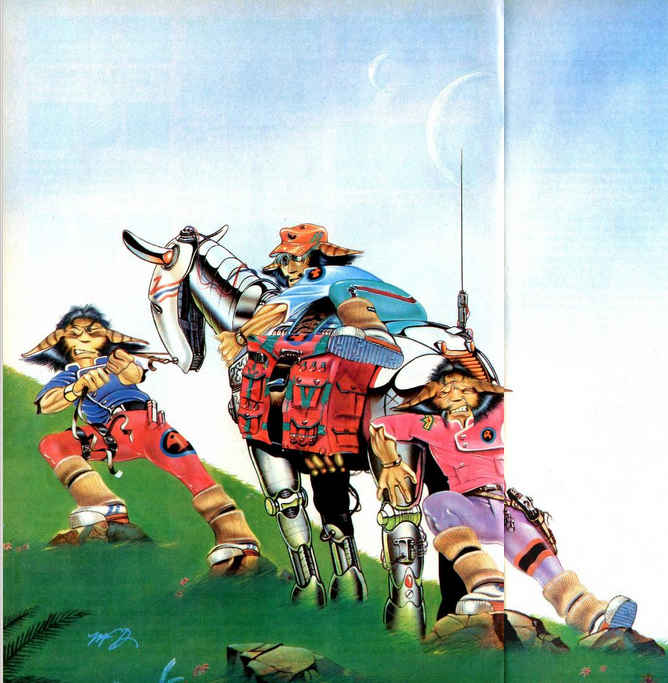
I wonder which alien race is that pointy-eared one? Maybe from a never-before-seen development prototype of M.U.L.E.? Who knows!!! 😉
M.U.L.E. (Electronic Arts / Atari, C-64 computers / 48K disk) is fast becoming a major craze among computer gamers. Winner of the 1984 Arcade Award as “Best Multi-Player Game”, M.U.LE. is a one- to four- player contest in which the participants strive to explore and exploit a habitable but deserted planet.
Each colonist must develop a strategy involving the supply and demand for materials which are vital to the settlement’s survival. By buying and selling food, energy, smithore, and (in the tournament version) crystite, the players attempt to gain the economic edge over their human and/ or computer-driven opponents. The player with the most assets at the end of the game is dubbed First Founder of the colony — assuming, that is, that all the cutthroat competition hasn’t doomed the outpost.
In a sense, M.U.LE. is a space-age cousin of such boardgames as Monopoly and Easy Money. Because it’s the interaction between the players that causes the largest changes in the game situation, it’s virtually impossible to take a “perfect plan” approach to this electronic strategy classic. Instead, this article will concentrate on providing some guidelines for developing your own individual strategies.
THE LAND GRANT
The first humble plot you choose is the basis for your future empire Choose the location well. The first plot
should be able to produce either food or energy, so go for flatland or river valley space. This guarantees that you’ll be at least partially self- sufficient. Keep that first acre within easy striking distance of other flatland ‘or mountain areas, and choose all sub- sequent plots adjacent to your first one
Expertise bonuses are awarded to players who keep their lands tightly- knit. The more adjacent plots you have, the more you’ll produce on each
one. Likewise, producing the same commodity on three different plots re- wards the colonist with more goods.
If land goes up for auction, always try to buy it, especially during the ear- liest phases. Each plot has an esti- mated value of $500, but it’s advisable to buy higher — if you have enough rounds left to produce plenty of goods. After the ninth round or so, if you pay too much for land, you prob- ably won’t be able to recover the cost from the goods produced on it if someone else is bidding higher than you and you don’t intend to buy, push the line up anyway and pretend you want it. Then pull out at the last second and leave your opponent holding the bag. It’s also advisable to leave yourself money to develop your brand-new plot, so never put all your cash on the line
LAND DEVELOPMENT & PRODUCTION
Now that you’ve got yourland, you have to decide what to do with it Produce food? A good idea if you have river or flat land. Energy? The same. Smithore can’t be mined in the wet river valley, and though it can be mined on flatlands, mountains are the ideal spot — the more mountains, the better!
Make enough food and energy to fulfill your needs. This will keep you from being at the mercy of your best friend, who’s likely to announce cheerfully, “Food? Gee, I think I have an extra unit or two. But you’ll have to pay for it! Players who have a food shortage will find their next development turn cut short proportionately, and lack of energy means low production.
The real key to the standard game is to produce smithore. Lots of it. It has a high base price and the store will always buy it. If you produce smithore towards the beginning of the game and then don’t sell, prices rise accordingly — and the colony experiences a shortage of M.U.L.E.s.
The development phase always seems too short. A few time-saving tips: When walking outside of town, avoid mountains and river land. They slow you down. The fastest walking is accomplished by moving diagonally Also, you don’t have to enter town through its side roads. Touch any portion of the center square, and bingo! You’re in. When entering town from the north or south, the character al- ways appears directly in front of the inn,
It’s possible to switch M.U.LE.s without having to remove the installed one. Just go into town, get the type of M.U.LE. you want, then position your character directly over the installed M.U.LE. Press the red button. If you’ve done it right, the production symbol changes and you now have the old M.U.L.E. in hand. If you do it wrong, the M.U.LE. you just bought runs away,
During the tournament game, two definite rules apply. First, forget about smithore. Go for crystite. Second, if you have time left after developing your land, pay the assay office a visit and check around for crystite. Also watch other players’ development turns because they’ll be searching for the stuff, also
THE AUCTION PHASE
All right, you just had the best development of your career. Now it’s time to sell off the surplus and buy what you need. This is really the most crucial phase of the game.
First and foremost, don’t ignore the value of psyching out the opposition (unfortunately, this only works on hu- man opponents)! Hard-core M.U.LE.ies know the placed comment like, looks a little low on energy. I’ll bet there’s a shortage coming up next turn.” (This often fools the others into buying out the stock, so use it only when you’re the one making the most
energy.)
Always buy low, sell high. Low prices are: food, $15; energy, $10: smithore, $36-$43; and crystite, anything below $100. Even if you have a 20-unit surplus, never sell at these prices — unless you really need the cash for the next development phase. Let the whole crop rot before selling it to the store at a pittance.
If the store is stocked up on a particular item (therefore setting the price at a standard level), don’t sell below the store’s price — unless an opponent is lowering his or her price. Instead, perch right on the store’s price line to get the highest price you can
The price of necessities is always relatively low — that is, until the store runs dry. After that, anything goes, so keep an eye on what goods will be in high demand in a turn or two. It’s always fun to watch the poor suckers offer hundreds of dollars for a unit of food! A good way to make sure the store runs out — don’t sell!
If you have enough food and energy, but your opponents don’t, seriously consider buying out the store if you can. That way, everyone suffers but you. ..and the price rises higher in the next auction!
Never sell anything during the final, 12th auction phase. The value of your goods remains higher if you don’t
IN GENERAL
It you have extra cash, buy smithore at $36 or $43, then sell it later when the price rises above $50.
Inthe tournament game, always try to grab any property hit by a meteor. It turns the plot into a super crystite producer.
Above all, stay flexible. if you have six energy plots and the store has, say, twenty units, convert those energy plots to something that will be more profitable. Constantly try to second: guess your opponents about what commodity is next on the short-supply list. Try to make what your enemies aren’t. That way, you can really gouge the prices, especially in the essential food and energy areas.
Stay cool, calm, collected, and above all, greedy. Nobody ever said the First Founder was a nice guy!
Joseph Fenton’s Strategy
Source: Old WoM
Note from WoM: This strategy only works on the Atari 400/800 version. But there, it works greatly. Therefore, you should always be wary when an Atari M.U.L.E. fan brags to you that he/she “reached a colony score of >150k$ easily”… 😉
One of the folks said “Never sell anything during the final, 12th auction phase. The value of your goods remains higher if you don’t”, but if you play MULE with multiple players, collusion in the last auction round is the key to winning. My brothers, my dad, and I (all avid MULE players) early on discovered this key secret: whatever the final price something sells for in the final auction is what ALL inventory of that item is worth in the final tally! Have one person with money buy, and have one person with at least one unit sell, then run the price up to the very last second, then let him buy one unit. This generates the most money on Crystite as the price goes up by 4’s; but applies to all items. We rarely had a game where the colony’s worth was less than 250,000. Stockpile as much as you can for the last round… all the way up to spoilage, then drive the price in the final auction for astronomical colony totals. Generally, whoever has the most Crystite will wind up the founder, but the idea is everyone looks good. Don’t worry about the computer interfering with this, the computer NEVER buys or sells in the final auction.
Darxi’s Strategy
Source: Old WoM
I’ve got the most insanely valable way to get RICH in M.U.L.E.! Unfortunatly, one person tends to not benefit, although it all worked because of them… Too bad. You have to buy all the crystite you can, while your buddy only needs one unit. The price for crystite has to be very low, less than 60. When you have 20+ units, get you and your buddy to the selling position. Make your buddy run to the top, and keep on running, driving the price high. For some reason, the AI will eventually go down, and attempt to buy from your buddy. This is when your buddy runs down, and you move up. For optimum results, the price should have been driven to at least 300. Please forgive me if this doesn’t work for you. This may be for one of the two reasons: 1- I played it on the Commandore 64. 2- I haven’t played it for at least 2½ months, so I could have forgotten the exact procedure. I’ll e-mail again if I did do something wrong in here, and I’ll have the correct procedure. Please, take this seriously, as it can get you 10,000 bucks, at least!

